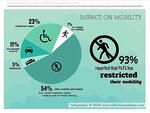Adrian's Health Card
This is my way to easily copy and paste a link that explains everything instead of trying to remember things! It's a simple overview of my current medical situation along with links to helpful resources where I got the information.
Type 1 Diabetes
"If you have type 1 diabetes, your pancreas doesn’t make insulin or makes very little insulin. Insulin is a hormone that helps blood sugar enter the cells in your body where it can be used for energy. Without insulin, blood sugar can’t get into cells and builds up in the bloodstream. High blood sugar is damaging to the body and causes many of the symptoms and complications of diabetes.
Type 1 diabetes (previously called insulin-dependent or juvenile diabetes) is usually diagnosed in children, teens, and young adults, but it can develop at any age."
https://www.cdc.gov/diabetes/basics/what-is-type-1-diabetes.html
POTS
"The current diagnostic criteria for POTS is a heart rate of 30 beats per minute (bpm) or more, or over 120 bpm, within the first 10 minutes of standing, in the absense of orthostatic hypotension."
Orthostatic hypotension is low blood pressure caused by standing up.
"Approxiamtely 50% of POTS patients have a small fiber neuropathy that impacts their sudomotor nerves. Many POTS patients also experience fatigue, headaches, lightheadedness, heart palpitations, exercise intolerance, nausea, diminished concentration, tremulousness (shaking), syncope (fainting), coldness or pain in the extremities, chest pain and shortness of breath."
"For others, symptoms may be so severe that normal life activities, such as bathing, housework, eating, sitting upright, walking or standing can be significantly limited."
For others, symptoms may be so severe that normal life activities, such as bathing, housework, eating, sitting upright, walking or standing can be significantly limited."
http://www.dysautonomiainternational.org/page.php?ID=30

Ehlers-Danlos Syndrome
"The Ehlers-Danlos syndromes (EDS) are a group of hereditary disorders of connective tissue that are varied in the ways they affect the body and in their genetic causes. The underlying concern is the abnormal structure or function of collagen and certain allied connective tissue proteins."
EDS tends to cause joint hypermobility, frequent dislocations of joints, and chronic joint pain.
Personally, I experience hypermobility in my wrists and frequent joint pain. I'm not honestly sure if it's EDS or not yet, but it seems to explain most of my symptoms in talking to people who are diagnosed with it.
https://www.ehlers-danlos.com/what-is-eds/
Mast Cell Activation Syndrome
"MCAS is a condition in which the patient experiences repeated episodes of the symptoms of anaphylaxis – allergic symptoms such as hives, swelling, low blood pressure, difficulty breathing and severe diarrhea. High levels of mast cell mediators are released during those episodes. The episodes respond to treatment with inhibitors or blockers of mast cell mediators. The episodes are called “idiopathic” which means that the mechanism is unknown - that is, not caused by allergic antibody or secondary to other known conditions that activate normal mast cells."
My main symptoms include itching, flushing, sweating, itchy and runny nose, dry mouth and throat, trouble breathing, low blood pressure, rapid heart rate, cramping, nausea, abdominal pain, headaches, dizziness, confusion, and fatigue.
https://www.aaaai.org/conditions-treatments/related-conditions/mcas#:~:text=MCAS%20is%20a%20condition%20in,are%20released%20during%20those%20episodes.
https://www.healthline.com/health/mast-cell-activation-syndrome#symptoms
Reynaud's Syndrome
"Raynaud's (ray-NOSE) disease causes some areas of your body — such as your fingers and toes — to feel numb and cold in response to cold temperatures or stress. In Raynaud's disease, smaller arteries that supply blood to your skin become narrow, limiting blood flow to affected areas (vasospasm)."
It causes skin, mainly in the fingers or toes, to turn white, red, then blue. Skin turns white when the bloodflow is cut off, then blue when it doesn't receive enough oxygen, then red as the blood returns.
https://www.mayoclinic.org/diseases-conditions/raynauds-disease/symptoms-causes/syc-20363571
Attention Deficit Hyperactive Disorder
"Many ADHD symptoms, such as high activity levels, difficulty remaining still for long periods of time and limited attention spans, are common to young children in general. The difference in children with ADHD is that their hyperactivity and inattention are noticeably greater than expected for their age and cause distress and/or problems functioning at home, at school or with friends."
"There is no lab test to diagnose ADHD. Diagnosis involves gathering information from parents, teachers and others, filling out checklists and having a medical evaluation (including vision and hearing screening) to rule out other medical problems. The symptoms are not the result of person being defiant or hostile or unable to understand a task or instructions."
https://www.psychiatry.org/patients-families/adhd/what-is-adhd
Unspecified Anxiety Disorder
"Other specified anxiety disorder and unspecified anxiety disorder are terms for anxiety or phobias that don't meet the exact criteria for any other anxiety disorders but are significant enough to be distressing and disruptive."
"Experiencing occasional anxiety is a normal part of life. However, people with anxiety disorders frequently have intense, excessive and persistent worry and fear about everyday situations. Often, anxiety disorders involve repeated episodes of sudden feelings of intense anxiety and fear or terror that reach a peak within minutes (panic attacks).
These feelings of anxiety and panic interfere with daily activities, are difficult to control, are out of proportion to the actual danger and can last a long time."
In my case, I was not being directly tested or monitored for anxiety, and I have not recieved more testing or monitoring to specify my anxiety.
https://www.mayoclinic.org/diseases-conditions/anxiety/symptoms-causes/syc-20350961